Welcome to the world of gardening, where nature’s beauty meets creativity and innovation. In this article, I’ll be sharing all about garden tips and tricks that will help you create a stunning outdoor space that you can be proud of. Whether you’re a seasoned gardener or just starting, there’s always something new to learn.
Key Takeaways:
- Understanding your hardiness zone and growing season is crucial for successful planting
- Proper pruning and soil preparation are essential for healthy plants
- Deadheading and providing sufficient sunlight are key for encouraging flower production
- Effective weed control and hosta division can help maintain a beautiful garden
- Leaving some plants during fall and planting bulbs in the fall adds to the beauty of the garden
- Quality soil and proper watering techniques are critical for plant growth
Remember, gardening is a continuous learning process. Every garden is unique and presents its own challenges. But with the right knowledge and techniques, anyone can create a beautiful and thriving garden. So, let’s dive in and discover all about garden tips, tricks, and innovations!
Understanding Your Growing Conditions: Hardiness Zones and Frost Dates
Before you get your hands dirty, it’s important to understand your growing conditions. By knowing your USDA Hardiness Zone and last frost date, you can make informed decisions about which plants and flowers will thrive in your garden.
The USDA Hardiness Zone is a map of the United States that divides the country into regions based on their average annual minimum temperatures. This information is useful when selecting plants and flowers that will survive the winter in your area. For example, a plant that is labeled as hardy to Zone 6 can withstand temperatures as low as -10°F.
| USDA Hardiness Zones | Temperature Range (°F) |
|---|---|
| 1 | -60 to -50 |
| 2 | -50 to -40 |
| 3 | -40 to -30 |
| 4 | -30 to -20 |
| 5 | -20 to -10 |
| 6 | -10 to 0 |
| 7 | 0 to 10 |
| 8 | 10 to 20 |
| 9 | 20 to 30 |
| 10 | 30 to 40 |
| 11 | 40 to 50 |
Another key factor in understanding your growing conditions is knowing your last frost date. This is the date in spring when the probability of frost occurring drops to 50%. Planting too early or late can result in damage to your plants. For instance, if you plant warm-season vegetables, such as tomatoes or peppers, too early, the cold weather will stunt their growth. On the other hand, planting them too late means they may not have enough time to mature before the first frost.
There are several ways to determine your last frost date. You can check with your local extension office, use an online tool, or keep track of the weather patterns in your area. Once you know your last frost date, you can plan when to start seeds indoors, when to transplant seedlings outdoors, and when to directly sow seeds in the ground.
By understanding your growing conditions, you can select plants and flowers that are best suited for your area and create an environment that promotes healthy growth. Remember to also consider factors such as soil type, sunlight exposure, and moisture levels when planning your garden.
Essential Garden Care: Pruning and Soil Preparation
To keep your garden thriving, proper care is essential. Learn how to prune spring-flowering shrubs at the right time and enhance your soil with composted manure for healthy plant growth.
Pruning is an essential aspect of good landscape design. The best time to prune spring-flowering shrubs is after they’ve finished blooming. This helps ensure the shrub will retain its natural shape and won’t interfere with next year’s blooms. Regular and proper pruning helps maintain a healthy, attractive landscape presentation.
Soil preparation is another imperative component of gardening. Fertilizers alone do not make a garden healthy and thriving. The proper soil quality is more important, so adding organic amendments like compost and well-aged manure enriches the soil and helps support plant life. Using composted manure in your garden provides nutrients for plants, increases soil fertility, and improves soil texture and structure. It is suggested that you apply composted manure to your garden bed every fall.
| Tip: | Use a hoe to cultivate the top 1-2 inches of the soil to help aerate it and prevent crusting. |
|---|
When it comes to landscaping, it is essential to know what your garden needs. Selecting the right plant for the right place makes a big difference. Plants, like humans, have specific requirements, including the amount of sun and shade they need. Some plants need full sun while others require partial shade. It is recommended to provide at least 8 hours of direct sunlight for vegetables and other types of plants that require full sun. Paying attention to the amount of sunlight plants receive is an essential factor in ensuring plant health and proper development.
Conclusion:
Essential Garden Care: Pruning and Soil Preparation are vital for maintaining a healthy garden. By following these practices, you can ensure your garden remains healthy and thriving.
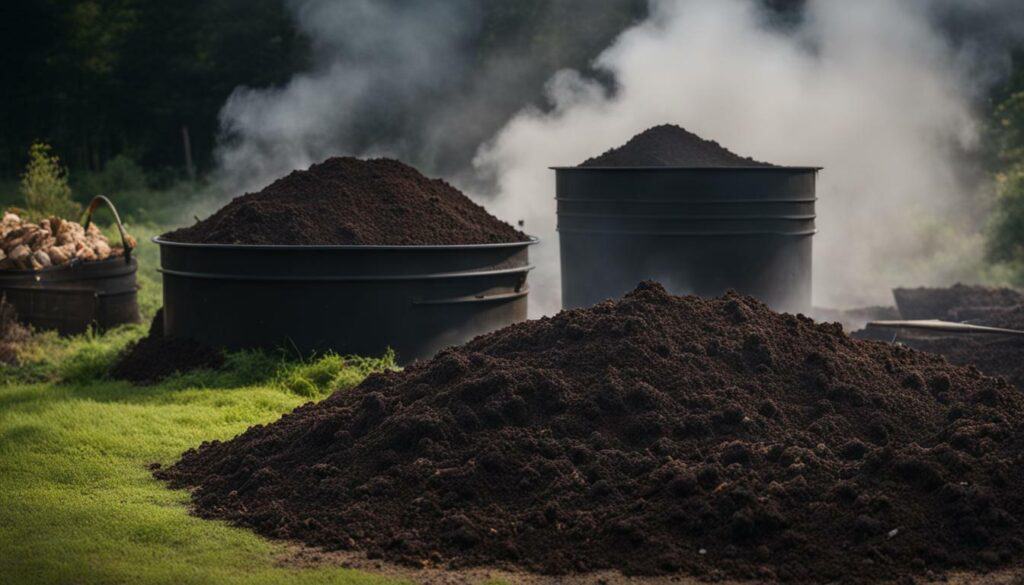
Patience Pays Off: Perennials’ Growth and Growing Season
When creating a garden, it’s important to be patient and understand the growth patterns of perennials. Unlike annuals that complete their life cycle in a single growing season, perennials need time to reach their mature size. It can take up to three years for perennials to reach their full potential size after planting. They follow a cycle of “sleep, creep, and leap” every year, which means that the first year, they will primarily focus on establishing their roots and won’t show much above-ground growth. The second year, they will slowly begin to grow, and by the third year, they will reach their mature size.
To ensure successful planting, it’s essential to know your USDA Hardiness Zone. Your hardiness zone will help you choose the right perennials that can survive in your area’s climate. By selecting plants that are hardy in your zone, you can avoid damage from extreme temperatures and ensure the plants thrive in your garden.
Another important aspect to consider is the growing season. Understanding your growing season, from the last frost date in spring to the first frost date in fall, can help you plan when to start planting. It’s crucial to ensure that you don’t plant too early in the spring and risk damage from late frosts or plant too late in the fall and risk damage from early frosts.
When it comes to pruning, it’s best to prune spring-flowering shrubs after the blooms fade to avoid removing next spring’s flower buds. It’s also important to use well-prepared soil, such as composted manure, to ensure your plants have the nutrients they need to thrive.
Deadheading perennials and annuals is a good practice to encourage more flowers and stronger growth. By removing faded flowers, you prompt the plant to produce more blooms. Light requirements vary among plants, so it’s important to provide the right amount of sunlight for optimal growth. Some plants, such as hostas, prefer shade, while others require full sun.
Weeding, mulching, and controlling pests are essential for maintaining a healthy garden. By keeping weeds under control, you reduce competition for nutrients and water. Mulching helps to retain moisture in the soil and suppress weed growth. Controlling pests, such as aphids and spider mites, can prevent them from causing harm to your plants.
Dividing and transplanting perennials should be done in late summer or early autumn. This allows ample time for the plants to establish their roots before the winter season. Knowing your hardiness zone and frost dates can help you choose the right plants and avoid damage from extreme temperatures.
Being patient with the growth process can lead to a beautiful and thriving perennial garden. By following these tips and understanding the growth patterns of perennials, you can create a garden that will bring joy and beauty for years to come.

Encouraging Flower Production: Deadheading and Sunlight Requirements
To achieve a garden bursting with color, it’s essential to know how to encourage flower production through deadheading and providing the right amount of sunlight. Deadheading, the removal of spent flowers, is a vital practice for perennials and annuals. This technique signals the plants to produce more flowers instead of focusing on seed production. Deadheading also promotes the growth of stronger leaves and roots, which can enhance the overall health of your plants. However, if you are growing plants for decorative fruits or pods, this practice is not recommended.
When it comes to providing the right amount of sunlight, different plants have different requirements. Most vegetables, for example, need at least 8 hours of direct sunlight daily for optimal harvest. However, cool-season crops like lettuce, spinach, radishes, and cabbage can tolerate some shade. On the other hand, panicle hydrangeas need sun for the best flowering. It is also advised to plant spring-blooming bulbs, such as tulips and crocuses, in the fall before the ground freezes to ensure they get enough sunlight to bloom.
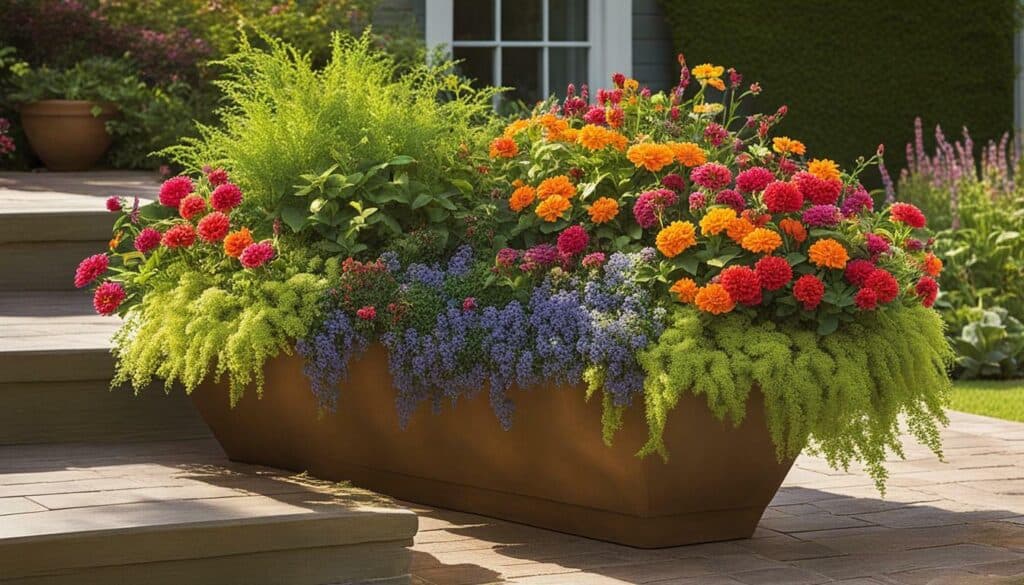
Container gardening is an excellent option for those with limited space or poor soil conditions. When it comes to container gardening, it’s important to ensure that your plants are receiving the correct amount of sunlight. You may need to move your containers around throughout the day to ensure they are getting enough sun.
To conclude, deadheading encourages flower production in plants, while providing the right amount of sunlight is essential for their growth and development. By understanding the unique needs of different plants, you can create a garden bursting with color and life.
Weed Control and Hosta Division
Maintaining a beautiful garden requires effective weed control techniques and knowing the best time to divide your hostas for optimal growth. When it comes to weed control, hand-weeding and hoeing are effective techniques that don’t disturb the soil as much as deep hoeing or cultivating. However, it’s important to avoid excessive hoeing as it can bring weed seeds to the soil’s surface, promoting their germination and growth.
Mulching is another technique that can help prevent annual weeds from growing. A layer of organic mulch, such as shredded leaves or bark, can smother weeds and prevent them from getting enough sunlight to grow.
As for hostas, they are generally low-maintenance plants that don’t require frequent division. However, if you want to rejuvenate an old plant or increase the number of hostas in your garden, division is a good option. The best times to divide hostas are in spring, as the new shoots appear and before the leaves unfurl, or in fall, at least four weeks before the soil freezes.
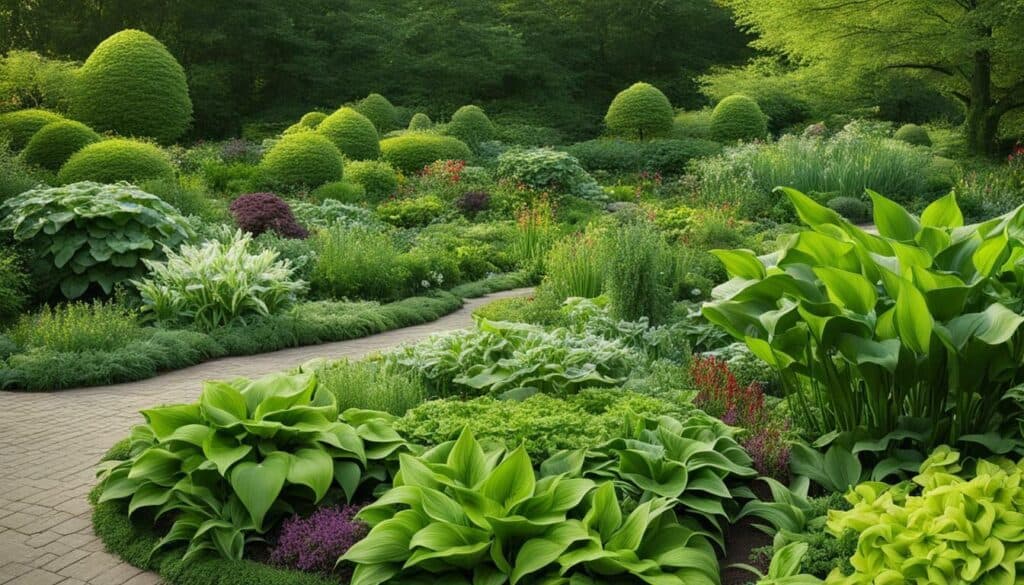
Tips for Effective Weed Control
| Technique | Description |
|---|---|
| Hand-weeding | Effective for small areas and shallow-rooted weeds. Make sure to pull out roots as well to prevent regrowth. |
| Hoeing | Best for larger areas and longer-rooted weeds. Make sure to hoe at a shallow angle to avoid bringing weed seeds to the surface. |
| Mulching | Prevents weed growth by blocking sunlight. Apply a layer of organic mulch in spring or fall, making sure not to smother the plants. |
Tips for Hosta Division
- Choose healthy plants with multiple shoots for division.
- Dig up the entire clump and gently separate the shoots by hand or using a clean knife or spade.
- Make sure each division has at least one growing point and a healthy root system.
- Replant the divisions at the same depth as they were previously growing, and water well.
“By taking care of weed control and dividing your hostas at the right time, you can ensure a healthy and beautiful garden for years to come.”
Enhancing Fall Beauty: Ornamental Grasses and Seed Heads
As an advocate for organic gardening practices, I believe in enhancing the beauty of your garden while also providing a habitat for wildlife. Learn how leaving ornamental grasses and seed heads can accomplish both.
When it comes to fall garden clean-up, don’t be too quick to remove everything. Ornamental grasses, such as switchgrass and big bluestem, offer beauty, texture, and movement to your garden throughout the fall and winter. Additionally, seed heads of flowers like coneflowers, black-eyed Susans, and asters can provide food for birds during the colder months.
But before planting anything, it’s important to select the right plants for your growing conditions. Consider your hardiness zone to ensure the plants you choose will survive in your yard. Also, know your frost dates to avoid planting too early or late in the season.
| Tip: | Select heat-tolerant plants in warm climates and give ground-gobbling vines like pumpkins and melons ample elbow room or a trellis to climb. |
|---|
Deadheading spent flowers on spring-blooming bulbs, such as daffodils and hyacinths, is another way to enhance the beauty of your fall garden while also benefiting the plants. By removing the spent flowers, the plants can focus their energy on growing stronger leaves and roots instead of seed production.
When it comes to caring for your plants, make sure to pay attention to their sunlight requirements. Vegetables need at least 8 hours of direct sunlight every day, while some shade is suitable for cool-season crops. Composted, rotted manure that has cured for at least six months is also an excellent way to improve soil quality. Avoid using fresh manure, which is too high in nitrogen and can burn plants.
Finally, dividing and transplanting spring-blooming perennials in late summer or early autumn is a great way to ensure their continued growth and health. Commonly divided perennials include irises, peonies, hostas, and daylilies. And don’t forget to plant your spring-blooming bulbs in the fall before the ground freezes for a beautiful display come spring.
By following these tips, you can enhance the fall beauty of your garden by incorporating ornamental grasses and seed heads, all while providing a healthy habitat for wildlife.
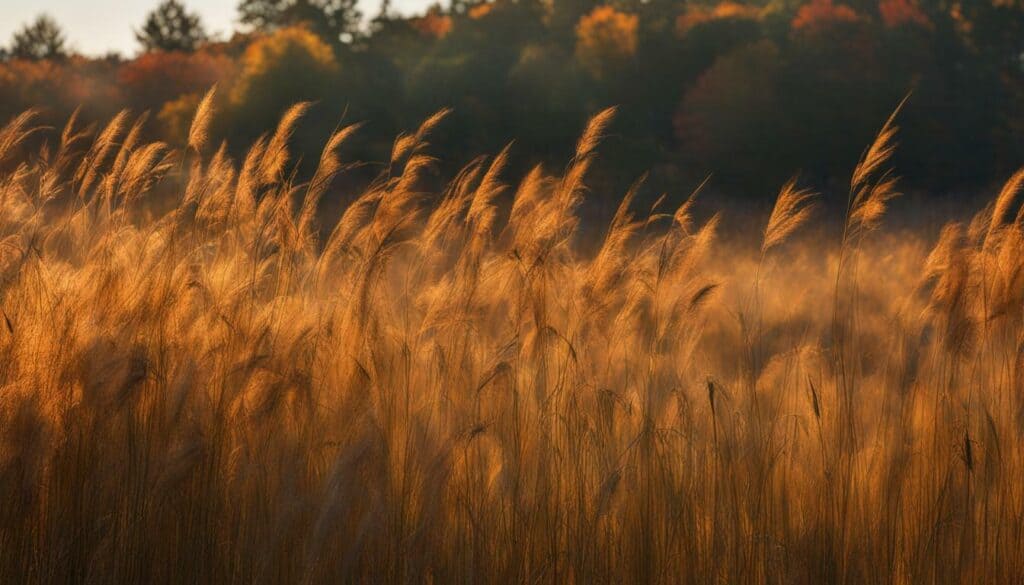
Tomatoes and Bulbs: Ripening and Care
Whether you’re an avid tomato grower or love the vibrant colors of spring-blooming bulbs, I have some essential tips for you to ensure optimal growth and beauty in your garden.
Tomato Ripening
Tomatoes are a staple in many gardens, but achieving optimal ripeness can be challenging. The ideal temperature for ripening tomatoes is between 68-77°F. Be sure to regularly check the temperature and avoid letting it get too high, as this can inhibit the production of pigments responsible for fruit color. If temperatures consistently drop below 50°F, green tomatoes won’t ripen on the vine. However, partially ripe tomatoes can be brought indoors to finish ripening.
Spring-Blooming Bulbs
When it comes to planting spring-blooming bulbs such as tulips and crocuses, timing is key. Plant bulbs in the fall before the ground freezes to ensure that they are established and ready to bloom in the spring. Place bulbs in a hole two to three times their depth and cover with soil. Deadhead spent flowers on spring-blooming bulbs to redirect energy to bulb development. Allow foliage to turn brown and remove gently.
Composted Manure
Improving soil quality is essential for optimal plant growth. Use well-prepared, composted manure that has cured for at least six months to avoid burning plants with excessive nitrogen. However, avoid using manure from pigs, dogs, and cats as it may contain harmful pathogens.
Match Plants to Growing Conditions
Choosing plants that match your growing conditions is the key to success. Give sun-loving plants ample sunlight and provide space for vines to climb. Know your USDA Hardiness Zone to avoid planting trees, shrubs, and perennials that won’t survive winters in your area.
Pruning
Pruning is the process of removing dead or damaged plant parts to promote new growth. Prune spring-flowering shrubs after the blooms fade to avoid removing next year’s flower buds. This will help to ensure that your shrubs bloom for years to come.
Dividing Perennials
Dividing perennials is an essential aspect of garden care. Hostas can be divided in spring as new shoots appear or in the fall, four weeks before the soil freezes solid. Late summer or early autumn is the best time to divide and transplant spring-blooming perennials.
Watering
Watering your plants properly is crucial for growth and health. In-ground garden plants require 1 to 2 inches of water per week. Water deeply once a week instead of lightly each day to encourage deeper root growth.
Conclusion
In conclusion, caring for your garden involves understanding temperature requirements for ripening tomatoes, planting bulbs in the fall, pruning at the appropriate times, providing sufficient sunlight, dividing perennials in the right season, and improving soil quality with organic amendments. By following these essential tips and tricks, you can unleash your creativity and enjoy the wonders of organic gardening!
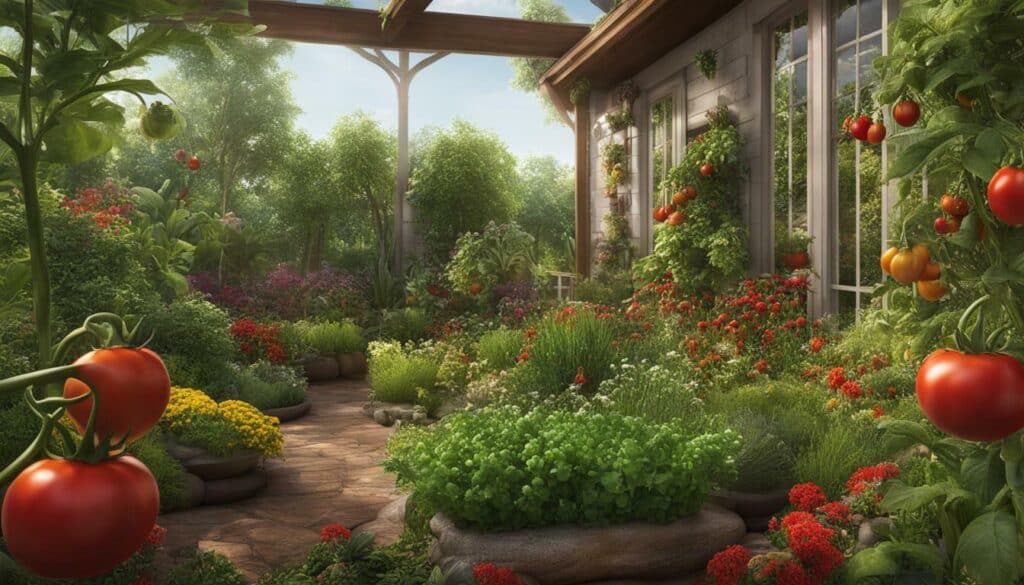
Watering and Fall Composting
Keeping your garden hydrated and nurturing it with nutrient-rich compost are key elements in maintaining a thriving garden. Let’s dive into the essentials of watering and fall composting.
Most in-ground garden plants grow best with 1 to 2 inches of water per week. If there is not enough rainfall, it is recommended to water deeply once a week instead of lightly each day. Frequent, shallow watering only moistens the top layer of soil, which encourages plant roots to stay shallow instead of growing deeper.
It is also important to pay attention to how much light different plants need. Most vegetables require at least 8 hours of direct sunlight each day for optimal growth. However, if you have some shade, you can still grow cool-season crops such as lettuce, spinach, radishes, and cabbage.
Instead of sending away fall leaves, they can be chopped up and used as compost ingredients. Composting is a great way to recycle organic materials and enrich the soil for the next growing season. It is advised to use only composted, rotted manure that has cured for at least six months. Fresh manure is too high in nitrogen and can burn plants, as well as potentially contain pathogens or parasites.
When it comes to composting, it is also important to add only well-aged manure and organic amendments like compost to the soil. These improve soil structure and provide essential nutrients for plant growth.
In conclusion, proper watering and fall composting are essential for maintaining a healthy garden and promoting the growth of plants. By paying attention to the amount of water and light your plants need, and utilizing fall leaves and well-aged manure as compost, you are well on your way to a successful garden season.
Conclusion: Unleash Your Creativity and Enjoy the Wonders of Gardening
Gardening is a journey that allows us to connect with nature, express our creativity, and reap the rewards of our efforts. Now armed with valuable tips, tricks, and innovative ideas, it’s time to let your garden flourish and bask in the beauty it brings.
Remember to choose plants that match your growing conditions and know your hardiness zone and frost dates. Gardening is a wonderful way to unleash your creativity and enjoy the wonders of nature.
Don’t be afraid to experiment and try new things in your garden. Get inspired and have fun!
By following these simple gardening tips, you can create a beautiful and thriving garden that will bring you joy all season long.
So, get out there and start digging! Let your garden be a source of pride and enjoyment, and always remember that nature is a great teacher. Happy gardening!
What Are Some Innovations That Can Make My Garden Easy to Maintain?
Looking for tips for easy garden maintenance? Consider investing in an automated irrigation system that will water your plants efficiently, saving you time and effort. Additionally, using self-watering planters can ensure your flowers and veggies get the right amount of hydration without constant monitoring. Opting for low-maintenance succulents and native plants will also reduce the need for frequent care and watering. Embrace innovative solutions to make your garden a breeze to maintain.
FAQ
Q: How can I determine my hardiness zone?
A: You can determine your hardiness zone by checking the USDA Hardiness Zone map, which divides regions based on average minimum winter temperatures.
Q: Why is it important to know my last frost date?
A: Knowing your last frost date is crucial for planting vegetables and fruits outside. It helps you avoid planting too early and risking damage from late spring frosts.
Q: When should I prune spring-flowering shrubs?
A: It’s best to prune spring-flowering shrubs immediately after the blooms fade. This preserves next spring’s flower buds.
Q: Can I use fresh manure in my soil?
A: It’s best to use composted, rotted manure that has cured for at least six months. Fresh manure and manure from certain animals can contain harmful pathogens and weed seeds.
Q: How long does it take for perennials to reach their mature size?
A: Perennials generally take three years to reach their mature size after planting. Patience is key!
Q: When should I divide hostas?
A: You can divide hostas in the spring as new shoots appear or in the fall before the soil freezes.
Q: How much sunlight do vegetables need?
A: Vegetables generally need at least 8 hours of direct sunlight per day. However, cool-season crops can thrive in shaded areas.
Q: How can I control weeds in my garden?
A: You can control weeds through hand-weeding and hoeing. Avoid deep hoeing or cultivating to prevent weed seed germination.
Q: Should I remove flower stalks from rhubarb plants?
A: Yes, removing flower stalks from rhubarb plants promotes foliage production and prevents the plant from diverting energy towards flowering.
Q: How should I store harvested potatoes?
A: To prevent the production of toxins due to exposure to light, store harvested potatoes in complete darkness.
Q: How much water do garden plants need?
A: Most garden plants need 1 to 2 inches of water per week. It’s best to water deeply once a week instead of lightly each day.
Q: Can I use fall leaves for composting?
A: Absolutely! Chop up and use fall leaves as compost ingredients. They provide valuable organic matter for your garden.
Source Links
- https://miraclegro.com/en-us/gardening-101/10-top-gardening-tips-for-beginners.html
- https://www.bhg.com/gardening/yard/garden-care/gardening-tips-for-every-gardener/
- https://www.hgtv.com/outdoors/gardens
- https://thisismygarden.com/2023/02/understanding-growing-zones/
- https://www.almanac.com/what-are-plant-hardiness-zones
- https://growingjoywithmaria.com/hardiness/
- https://www.gardendesign.com/how-to/
- https://www.almanac.com/gardening-tools-guide
- https://ianrnews.unl.edu/plants-take-patience-pay
- https://chippewavalleygrowers.com/perseverance-the-things-we-learn-from-plants/
- https://napavalleyregister.com/lifestyles/patience-pays-off-in-the-perennial-garden/article_c95f9ec6-3638-5f46-8286-354e42cb4f38.html
- https://www.fiskars.com/en-us/gardening-and-yard-care/ideas-and-how-tos/pruning-and-trimming/deadheading-flowers
- https://gardentherapy.ca/deadheading-flowers-to-increase-blooms/
- https://home.howstuffworks.com/gardening/garden-design/deadheading-flowers.htm
- https://www.nhhostas.com/dividing-hostas/
- https://www.bhg.com/gardening/flowers/perennials/how-to-divide-hostas/
- https://www.nola.com/entertainment_life/home_garden/garden-advice-how-to-divide-hostas-and-different-strategies-for-several-different-kinds-of-weeds/article_877adf52-ebd4-11eb-ab7e-2734271666fb.html
- https://ianrnews.unl.edu/0411052.html
- https://www.coohom.com/article/enhancing-your-backyard-garden-beds-with-ornamental-grasses
- https://www.finegardening.com/article/ornamental-grasses-in-the-fall
- https://www.almanac.com/plant/tomatoes
- https://www.bhg.com/gardening/vegetable/vegetables/why-are-my-tomatoes-not-ripening/
- https://www.thespruce.com/top-tomato-growing-tips-1402587
- https://www.spring-green.com/learn/blogs/blog-fall-composting-guide
- https://blog.jungseed.com/fall-composting-for-beginners/
- https://www.gardeners.com/how-to/all-about-composting/5061.html
- https://www.plantandsip.com/gardening-for-stress-relief
- https://botanyorbust.medium.com/unleashing-creativity-in-garden-design-4a2154c4c0d8
- https://journals.ashs.org/horttech/view/journals/horttech/32/3/article-p304.xml





Leave a Reply